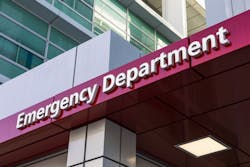An Ascension ED Physician Leader’s Message to Patients: ‘We’re Safe and Ready for You’
For many health systems across the country, having to cancel or delay certain procedures the past few months as a precautionary measure to ensure there would be ample space for COVID-19 patients has resulted in financial disaster. A late May report from Kaufman Hall, for example, found that steep volume and revenue declines hit U.S. hospitals hard in April, driving hospital operating margins down 282 percent compared to the same period last year and 326 percent below budget. The American Hospital Association (AHA), meanwhile, has recently projected financial losses to hospitals and health systems in 2020 to reach at least $323.1 billion.
As one might imagine, hospitals want to ramp up getting patients back in for services that were previously withheld. But one theme that’s appeared to emerge is patients still not feeling comfortable enough as they once were to return to care delivery facilities. According to a May Alliance of Community Health Plans (ACHP) and AMCP survey, 42 percent of nearly 1,300 surveyed patients said they feel uncomfortable going to a hospital for any medical treatment, while 38 percent intend to delay future care, treatment, and procedures.
At the 150-hospital based Ascension, which operates in 20 U.S. states, Allison Bollinger, M.D., vice president of emergency services across all hospitals, system-wide, contends that the emergency department (ED) situation has dramatically shifted from the early days of the pandemic when hospitals had to tell patients not to come through unless they absolutely had to. “We asked people to avoid the ED and they listened,” says the Tennessee-based Bollinger, who in addition to overseeing 150 Ascension emergency departments, is a practicing ER physician. “Although we really didn’t see the degree of [COVID] patient surges that we were expecting—though we did have hotspots—people were obeying the stay-at-home orders and distancing themselves. They were really following our instructions,” she says.
The unfortunate side effect of delaying care, however, was that individuals who really needed emergent care, such as heart attack and stroke patients, were also afraid to go the ED for their medical needs, says Bollinger. “So we saw an increase in patients dying at home and avoiding emergency medical care,” she sadly acknowledges. “Patients have assumed that once they walk into the ED and it will be full of COVID patients coughing on them, but we have now done so much to separate our viral respiratory patients from our other patients, [such as] masking every patient, and making sure all our personnel are well and have proper PPE,” she adds.
Indeed, EDs across Ascension are shifting in response to the health crisis, she contends, as the past few months of learning in the trenches has allowed the health system to create tools to make ED physicians and operations “more nimble.” Bollinger adds, “We’re asking patients to come to the ER. We are telling them not to avoid the ER; we are prepared and it’s safe here, regardless of what your emergent medical need is.”
One example of a “contactless” tool being used at Ascension today is a remote registration platform, affording patients the ability to spend less time in waiting rooms completing redundant forms and entering duplicate data. This platform, provided by R1 RCM, is part of the health system’s broader patient experience infrastructure, and was in place before the pandemic hit, Bollinger says. It has ramped up significantly in the past few months. She notes that once patients use this mobile registration tool, if they do come back to the ED, they want to use it again.
What’s more, like many other health systems, telehealth has become a much more acceptable way for providers to interact with patients at Ascension. Clinical and IT leaders are now looking at ways to leverage telehealth in our EDs to create a hybrid experience, Bollinger offers. When patients initially present, they have a telehealth conversation with a provider at the very earliest part of their experience, and at the end of the visit, they could have an in-person experience with a provider when there is more hands-on time, Bollinger explains. “This limits exposure, limits PPE utilization, and provides a hybrid experience that we’re finding patients welcome, as they see us trying new ways to protect their health and streamline their experience,” she says.
Managing patients at home has also become a greater priority, she adds. If there’s a way for a patient who is “borderline” for an admission to stay out of the hospital, “we consider that a win, but we do need to still keep eyes on them.” In this context, Ascension has remote monitoring tools being implemented across the health system, allowing patients to be sent home with monitoring devices and be checked on regularly by providers, Bollinger explains. “So our providers are asking how they’re feeling, what these tools are saying about their vital sings, what their respiratory rates are, and what their pulse oximeters saying. We can manage these people when they’re at home and keep [everyone] safer.”
Notably, Bollinger shares, the patients coming into the ER today are typically sicker as lower-acuity patients have recognized that there are other opportunities for them to seek care both virtually and in urgent care settings. This is leading to a recent uptick in Ascension’s ED volume, with sicker patients who truly need emergency care coming in, she explains. Even so, across the board at Ascension, even in places that have higher numbers of COVID cases, ED admission volumes are still lower than what they were a year ago, Bollinger reports.
She adds, “The patients who are coming into the ED and who are willing to reengage with that experience are typically patients who have more complicated medical issues or more life threatening emergencies. They are [often] facing emergent medical issues that can’t wait any longer. They’re hearing our call to come to us, and hearing that it’s a safe place and we’re ready for you.”


